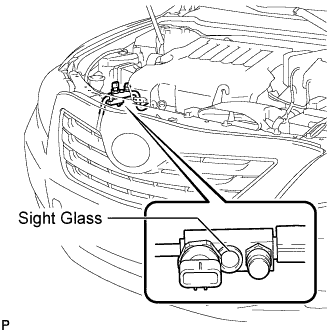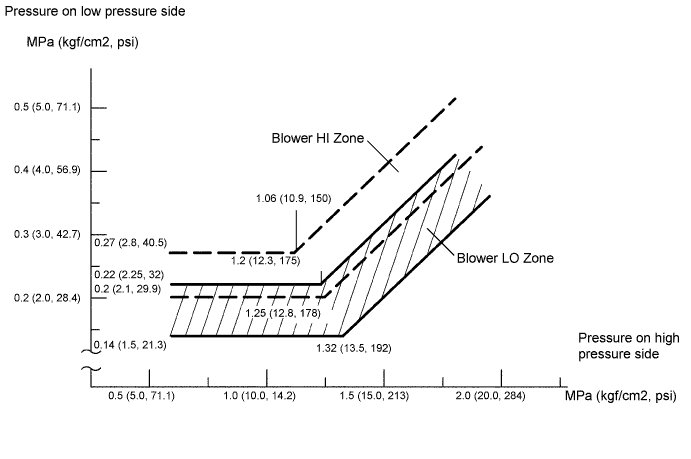Heater & Air Conditioning System. Camry. Acv40 Gsv40
Air Conditioning. Camry. Acv40 Gsv40
Refrigerant -- On-Vehicle Inspection |
| 1. INSPECT REFRIGERANT VOLUME |
Check the sight glass on the air conditioning tube and accessory.
Prepare the vehicle according to the chart below.
Item Condition Vehicle door Fully open Temperature setting MAX COLD Blower speed HI A/C ON Compare the sight glass to the following chart.
*: Bubbles in the sight glass with the vehicle's interior temperature above 35°C (95°F) can be considered normal if cooling is sufficient.Item Symptom Amount of refrigerant Corrective Actions 1 Bubbles exist Insufficient* - Check for gas leakage and repair if necessary
- Recharge with proper amount of refrigerant
2 No bubbles exist (DTC 76 is output) Empty, insufficient, or excessive Refer to 3 and 4 3 No temperature difference between compressor inlet and outlet Empty or nearly empty - Check for gas leakage and repair if necessary
- Evacuate the AC system and recharge with the proper amount of refrigerant
4 Considerable temperature difference between compressor inlet and outlet Proper or excessive Refer to 5 and 6 5 Immediately after air conditioning is turned off, refrigerant remains clear Excessive - Recover refrigerant
- Evacuate the AC system and recharge with the proper amount of refrigerant
6 Immediately after air conditioning is turned off, refrigerant foams and then becomes clear Proper - - Check for gas leakage and repair if necessary
 |
| 2. INSPECT REFRIGERANT PRESSURE WITH MANIFOLD GAUGE SET |
- HINT:
- This is a method where a manifold gauge set is used to help locate the problem.
Read the manifold gauge pressure when the following conditions are established.
Test conditions:- Temperature at the air inlet with the switch set at RECIRC is 30 to 35°C (86 to 95°F)
- Engine is running at 1,500 rpm
- Blower speed control switch is at "HI"
- Temperature control dial is at "COOL"
- A/C switch is ON
- Doors are fully open
- Ignition switch is in a position that enables the AC compressor to run.
Normally functioning refrigeration system
Gauge reading Pressure side Refrigerant volume Low 0.15 to 0.25 MPa (1.5 to 2.5 kgf/cm2, 21.3 to 35.5 psi) High 1.37 to 1.57 MPa (14 to 16 kgf/cm2, 199.1 to 227.5 psi) Moisture is present in refrigeration system.

Symptom Probable Cause Diagnosis Corrective Actions During operation, pressure on low pressure side cycles between normal and vacuum Moisture in AC system will freeze at the expansion valve orifice, causing the refrigeration cycle to temporarily stop
After the system stops, and warms up again, the ice will melt and normal operation will be temporarily restored- Cooler dryer (integrated into condenser tank) in oversaturated state
- Moisture in refrigeration system freezes at expansion valve orifice and blocks circulation of refrigerant
- Replace cooler dryer
- Remove moisture in system by repeatedly evacuating air
- Supply a proper amount of new refrigerant
- Cooler dryer (integrated into condenser tank) in oversaturated state
Insufficient cooling

Symptom Probable Cause Diagnosis Corrective Actions - Pressure is low on both low and high pressure sides
- Bubbles are seen through sight glass continuously
- Insufficient cooling performance
Gas leakage from the refrigeration system - Insufficient refrigerant
- Refrigerant leaking
- Check for gas leakage and repair if necessary
- Supply a proper amount of new refrigerant
- If the gauge indicates a pressure of close to 0, then it will be necessary to evacuate the system after repairing the leak
- Pressure is low on both low and high pressure sides
Poor circulation of refrigerant

Symptom Probable Cause Diagnosis Corrective Actions - Pressure is low on both low and high pressure sides
- Frost exists on pipe from condenser to unit
Refrigerant flow is obstructed by dirt inside the pipes of the condenser core Receiver is clogged Replace condenser - Pressure is low on both low and high pressure sides
Refrigerant does not circulate.

Symptom Probable Cause Diagnosis Corrective Actions - Vacuum is indicated on low pressure side and very low pressure is indicated on high pressure side
- Frost or condensation is seen on piping on both sides of receiver/drier or expansion valve
- Refrigerant flow is obstructed by moisture or dirt in refrigeration system
- Refrigerant flow is disrupted by gas leaking internally through the expansion valve
Refrigerant does not circulate - Check the expansion valve
- Replace expansion valve
- Replace condenser
- Evacuate air and supply a proper amount of new refrigerant
- For internal gas leak at expansion valve, replace expansion valve
- Vacuum is indicated on low pressure side and very low pressure is indicated on high pressure side
Refrigerant is overcharged or cooling effectiveness of condenser is insufficient.

Symptom Probable Cause Diagnosis Corrective Actions - Pressure is too high on both low and high pressure sides
- No air bubbles are seen through sight glass even when engine rpm lowers
- Unable to develop sufficient performance due to excessive use of refrigeration system
- Cooling effectiveness of condenser is insufficient
- Excessive refrigerant in cycle → excessive refrigerant was added during recharging
- Condenser cooling effectiveness is insufficient → condenser fins are clogged at cooling fan
- Clean condenser
- Check the operation of the condenser cooling fan
- If 1 and 2 are normal state, check the amount of refrigerant and supply proper amount of refrigerant
- Pressure is too high on both low and high pressure sides
Air is present in refrigeration system.

Symptom Probable Cause Diagnosis Corrective Actions - Pressure is too high on both low and high pressure sides
- The low pressure piping is too hot to touch
- Bubbles can be seen through sight glass
Air in system - Air present in refrigeration system
- Insufficient vacuum purging
- Check compressor oil to see if it is dirty or insufficient
- Evacuate the system and recharge it with new or purified refrigerant
- Pressure is too high on both low and high pressure sides
Expansion valve malfunction

Symptom Probable Cause Diagnosis Corrective Actions - Pressure is too high on both low and high pressure sides
- Frost or a large amount of condensation on piping on low pressure side
Expansion valve may be sticking - Excessive refrigerant in low pressure piping
- Expansion valve opened too wide
Check expansion valve - Pressure is too high on both low and high pressure sides
Insufficient compressor compression

Gauge readings (Reference)Symptom Probable Cause Diagnosis Corrective Actions - Pressure is too high both on low and high pressure sides
- Pressure is too low on high pressure side
Internal leak in compressor - Low compression
- Leak from a damaged valve, or parts may be broken
Replace compressor 
- Pressure is too high both on low and high pressure sides

- Temperature at the air inlet with the switch set at RECIRC is 30 to 35°C (86 to 95°F)